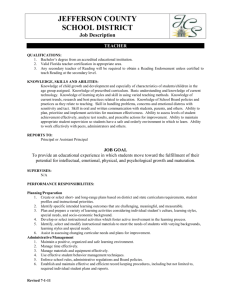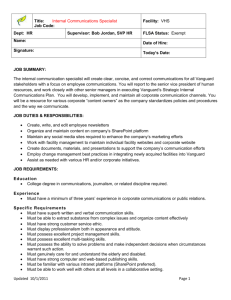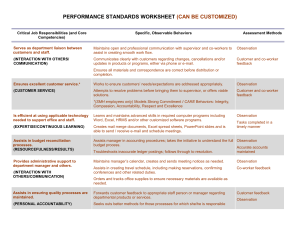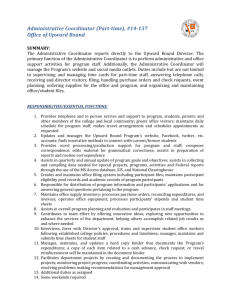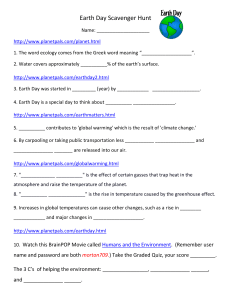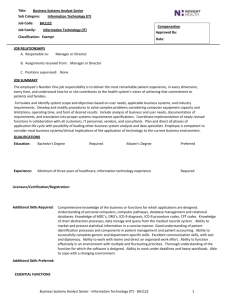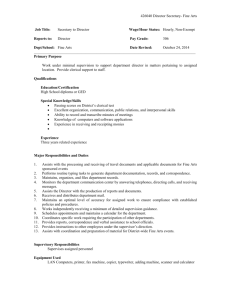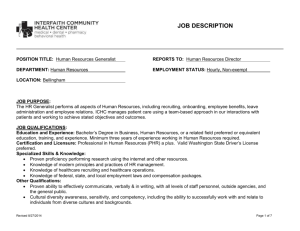Date prepared - 11/27/02 - Transylvania University
advertisement
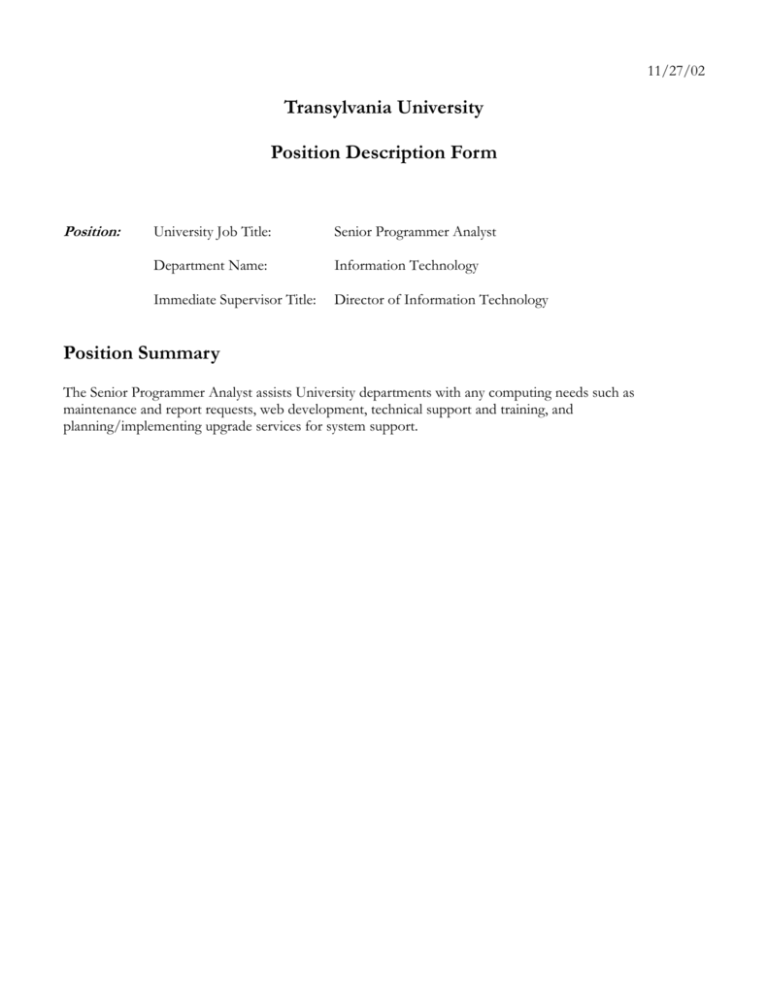
11/27/02 Transylvania University Position Description Form Position: University Job Title: Senior Programmer Analyst Department Name: Information Technology Immediate Supervisor Title: Director of Information Technology Position Summary The Senior Programmer Analyst assists University departments with any computing needs such as maintenance and report requests, web development, technical support and training, and planning/implementing upgrade services for system support. Duties and Responsibilities List the duties and responsibilities of the position, beginning each duty with an action verb. Essential Duties: 1. Provides tech support. A. For the Registrar’s Office: 1) Creates and maintains registration information through REGIDIS. 2) Modifies and maintains transcript print program. 3) Creates and maintains Grade Distribution Reports within Excel. 4) Creates and maintains programs that e-mail grades, rosters, and schedules to students and advisors. 5) Assists with numerous other statistical reports and extracts. 6) Provides data extracts for vendors or government agencies. 7) Maintains terminals. 8) Provides graduate information/labels. 9) Creates, maintains, and updates Faculty Information Center, an online repository of class rosters, advisor/advisee lists, major/minor lists, transcripts, and degree audit information. B For the Office of Financial Aid: 1) Maintains import between PowerFaids and Colleague award information. 2) Provides data extracts of Applicant data. C. For Admissions: 1) Creates and maintains program for visit statistics. 2) Maintains letters through mail merges. 3) Imports and crashes EOS, ACT, & NRCCUA. D. Provides tech support & training for Greek Life and Athletics: 1) Provides grade reports. 2) Trains worker(s) on adding/deleting/changing roster data. E. Provides limited tech support for Alumni & Development: 1) Creates and maintains Weekly Reports. 2) Creates and maintains Annual Reports. 3) Provides data extracts for Milestone Mailings. 2. Designs, codes, and tests software for departments using UniBasic code, UniQuery, or other vendor supported software. 3. Assists departments in streamlining tasks to better utilize the Colleague system through finding short cuts, importing data from third party vendors, etc. 4. Publishes online faculty/staff and student phone directories for Publications. 5. Initiates or assists with hardware/software upgrades as needed: A. Helps users implement new features of the Colleague system. B. Interacts with users as needed to resolve any difficulties after new systems have been implemented. C. Documents requests. D. Trains users on new systems or features. 6. Responds to reports of hardware failures by either correcting the problem or calling for service on equipment. 7. Ensures system security: A. Sets up new user accounts. B. Controls user access. C. Remains current in Unix and Unidata security issues. 8. Provides various training (Colleague, MS Office, other) as needed. 9. Develops a Disaster Recovery Plan with co-workers. 10. Takes responsibility for staying updated on the system and software by self study or by attending classes. Secondary Duties: 1. 2. 3. Provides tech support to other administrative offices as needed if the primary contact person is unavailable. Assists administrative offices with problems associated with MS Office. Performs other duties as assigned. Position Dimensions Please do not indicate personal qualifications but rather the job requirements. Education and Experience: The minimum amount of education and experience required. Specify the field of study or area of training, specific skills, and areas of experience. Bachelor's degree in Computer Science, Information Systems, or related field and two years of related experience required. Database experience and knowledge of MS Office and Datatel software products preferred. Supervisory Responsibility: List the number of people you supervise and titles. N/A Decision-Making Authority: Give examples of decisions you make independently as well as those in which you make recommendations for action to your supervisor. Develops computer programs to streamline business processes related to administrative information. Recommends purchases for software/hardware upgrades/training to supervisor. Contacts: Describe the type and extent of contacts with individuals, including other University employees, individuals outside the University, and students. Individual has daily contact with staff. Limited contact with students and faculty as well as software vendors also occurs. Technology: Describe how computers or other technological equipment is used to complete tasks electronically. Processes all administrative information regarding alumni, students, faculty, staff, & vendors electronically within the Datatel products Colleague and Benefactor. Word and Excel (sometimes Access) are used to generate some mail merges and some statistical reports based upon information housed within the Datatel system. Problems and Challenges: Briefly describe the principle challenges encountered in the position. a) Providing a balance between what is technologically capable theoretically and implementing those capabilities practically in a work-environment consisting of differing (and sometimes opposing) needs. b) Supporting & training individuals with various levels of computer skills. Provide examples of typical problems that are dealt with in the position. Data input/output manipulation. Working Conditions Component Working conditions are the physical surroundings of a worker in a specific job. Mark the work conditions that are present on the job. 75% or more of the work is performed indoors 75% or more of the work is performed outdoors Work is performed in equal amounts inside and outside Extremes of cold and temperature changes Extremes of hot and temperature changes Wet Surroundings: Contact with water or other liquids. Humid Surroundings: Atmospheric condition with moisture content sufficiently high to cause marked bodily discomfort. Sufficient noise, either constant or intermittent, to cause marked distraction or possible injury to the sense of hearing. Sufficient vibration (production of an oscillating movement or strain on the body or its extremities from repeated motion or shock) to cause bodily harm if endured day after day. Fumes such as smoky or vaporous exhalations thrown off as the result of combustion or chemical reaction. Odors to include any disagreeable sensation, stimulation, or perception of the sense of smell. Dust such as textile dust, flour, wood, leather, feathers, etc., and inorganic dust such as silica and asbestos which make the workplace unpleasant. List any other disagreeable elements present in the work environment. Strength Rating Following are descriptions of the five terms in which the Strength Requirement is expressed. Check the appropriate description that best describes the overall physical demands of the position. S-Sedentary Work - Exerting up to 10 pounds of force occasionally (Occasionally: activity or condition exists up to 1/3 of the time) and/or a negligible amount of force frequently (Frequently: activity or condition exists from 1/3 to 2/3 of the time) to lift, push, carry, pull, or otherwise move objects, including the human body. Sedentary work involves sitting most of the time, but may involve walking or standing for brief periods of time. Jobs are sedentary when walking and standing are required only occasionally and all other sedentary criteria are met. L-Light Work - Exerting up to 20 pounds of force occasionally, and/or up to 10 pounds of force frequently, and/or a negligible amount of force constantly (Constantly: activity or condition exists 2/3 or more of the time) to move objects. Physical demand requirements are in excess of those for Sedentary Work. Even though the weight lifted may be only a negligible amount, a job should be rated Light Work: (1) when it requires walking or standing to a significant degree, or (2) when it requires sitting most of the time but entails pushing and/or pulling of arm or leg controls; and/or (3) when the job requires working at a production rate pace entailing the constant pushing and/or pulling of materials event though the weight of those materials is negligible. NOTE: The constant stress and strain of maintaining a production rate pace, especially in an industrial setting, can be and is physically demanding of a worker even though the amount of force exerted is negligible. M-Medium Work - Exerting 20 to 50 pounds of force occasionally, and/or 10 to 25 pounds of force frequently, and/or greater than negligible up to 10 pounds of force constantly to move objects. Physical Demand requirements are in excess of those for Light Work. H-Heavy Work - Exerting 50 to 100 pounds of force occasionally, and/or 25 to 50 pounds of force frequently, and/or 10 to 20 pounds of force constantly to move objects. Physical Demand requirements are in excess of those for medium work. V- Very Heavy Work - Exerting in excess of 100 pounds of force occasionally, and/or in excess of 50 pounds of force frequently, and/or in excess of 20 pounds of force constantly to move objects. Physical Demand requirements are in excess of those for Heavy Work. Employee Signature: _____________________________ Date: ____________________ Supervisor Signature: _____________________________ Date: ____________________ Dean, VP or Administrator Signature: _____________________________ Date: ____________________
